World Nutrition
Volume 3, Number 8, August 2012
Journal of the World Public Health Nutrition Association
Published monthly at www.wphna.org
The Association is an affiliated body of the International Union of Nutritional Sciences For membership and for other contributions, news, columns and services, go to: www.wphna.org
Commentary: The best food on earth. Peru
The union of agriculture,
gastronomy, nutrition

Enrique Jacoby
Regional Advisor, Healthy Eating and Active Living
Pan American Health Organization, Washington DC, USA
Email: jacobyen@paho.org
Click here for member's profile
Patricia Murillo
Researcher in anthropology and ethnohistory
Access pdf of linked July commentary here
Introduction
Editor's note
Last month's commentary on Peruvian food systems and cuisine by Enrique Jacoby has been followed by many enquiries about the native and established foods of Peru, and Peruvian cuisine. So we invited Enrique and Patricia Murillo to give some more details, of the foods themselves, and of the methods of preparation and cooking that have already made authentic Peruvian cuisine among the best in the world. The authors and the editors spent some time debating the title of the commentary. Shouldn't we mention food culture, traditional food systems, family farms, and agriculture appropriate for climate and terrain? Well, all these are implied. And what about this concept of 'gastronomy', doesn't that imply only expensive restaurants? We think not, and that it's time to rescue the term and use it in its proper sense of delight in food. 'Can we include pictures of the fruits and foods and dishes themselves?' Enrique and Patricia asked. Yes, you can. 'In a nutrition journal?' Yes, and all the more reasons why.
We are honoured by Colin Tudge's introductory words to our first commentary last month, 'Peru: As good as it gets', where he poses the question: 'How, then, would this combination of sound nutrition and enlightened farming match the demands of gastronomy?', and immediately answers: 'Absolutely perfectly'.
We agree, and maintain that history validates this response. Our task here – and surely this is a task for all who are committed to the good health of populations – is to reinstate the union of agriculture, gastronomy and nutrition. This challenge has many aspects. These include the recognition and protection of family and cooperative farming, the physical rural environment, and indigenous and established food systems and food cultures. We believe that our country of Peru is a good place to begin.
This brief commentary, following that published last month, is largely a celebration of the ingredients and foods that have contributed to the wide range of flavours and colours and unique characteristics of today's Peruvian cuisine. Many of the crops that are making a swift comeback and becoming part of today's Peruvian cuisine, were disdained until recently by the Criollo (Creole) ruling and middle classes who, as descendants of the Spanish conquerors, tended to reject native cultures in favour of those from Europe. This started gradually to change within the last 25 years, due to several converging – though not always coordinated – initiatives. The first major change was pioneered by Peruvian celebrity chefs and other entrepreneurs, and countless creative local cooks. Change progressed with the engagement of the Peruvian Association of Gastronomy, which has given to what seemingly started as a 'food craze', the complete character of a cultural, social and professional movement.
Although aiming at diverse objectives, some previous Peruvian governments have given a special value to traditional foods, and have opened foreign markets for them. This contributed to the increased popularity of these foods among Peruvians themselves. Capping this enthusiasm, in 2005 President Alejandro Toledo enacted a decree giving Peruvian gastronomy the official status of 'national flagship product'.
The recognition of the value of indigenous and established foods, and their protection and defence, has meant that family farmers have regained a lost prestige, with the result that local economies are reviving. In 2010, leading Peruvian chefs and food writers took their commitment to defend national biodiversity further, and campaigned for a ten-year ban on the introduction of genetically modified crops. When the debate among legislators became open to public discussion, the Peruvian Association of Gastronomy pushed harder for the ban, which became law in 2011.
Peruvian food culture now is an astonishing rich mixture of food systems. These combine the ancient traditions of the original people with those that have come from Europe, Africa and Asia. It would be a mistake to think that what is happening in Peru is merely an attraction for rich people and tourists. The Peruvian food movement is truly national.
The wonders of Peruvian food

There are up to 3,000 varieties of potato in Peru (some shown right), which are harvested throughout the country (left). The potato originated in the Andes
To begin with potatoes: these hardy tubers are Peru's staple food gift to the world. It is well-known that potatoes originated in the Andean region of Peru and Bolivia, where they have been cultivated certainly since around 8,000 years ago. They become a staple food for the original populations, then the Incas, and then the Spanish; and were then exported. Around 250 years ago potatoes began to become a staple food in various parts of the world, including Europe and North America. Now, something like 350 million tons of potatoes are produced every year, or around 35 kilograms per person on the planet per year. There is a difference, though. Most potatoes consumed as such or processed into French fries (chips) or chips (crisps) are from a small number of varieties suitable for processing. By contrast, it is reckoned that there remain up to 3,000 varieties of potato in Peru. This heritage of biodiversity is now increasingly guarded in Peru. Here are five types:

The papa amarilla (left) has a buttery flavour, bright-yellow flesh when cooked, and a very soft, grainy texture. It is most commonly used for making causa (see below) and mashed potatoes, and is also fried or boiled and eaten with spicy sauces. The papa huamantanga (next), ignored for centuries, has become a big favourite in recent times. It has a pale and creamy flesh, and a flavour similar to that of papa amarilla. It has become the most favoured option for stews. Next is the papa morada, a purple native variety easier to find in the US and Europe than in Peruvian urban areas, where it is still exotic and rare. Next is papa peruanita, named after the country because of the national colours, red and white, in its skin. When boiled it becomes very soft and works very well in a variety of recipes. At right is pusi qachun waqachi, which means 'makes the daughter-in-law cry'. According to an indigenous tradition in rural Cuzco, when a future mother-in-law wants to test the woman who is going to marry her son, she gives her this potato to peel. If she can peel it without damaging the pulp, it means she is a good cook and will be able to take good care of her son.
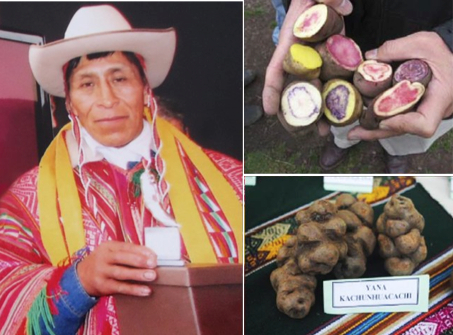
Julio Hancco Mamani (above) feted in Peru as a 'general of biodiversity' grows 200 types of potato in his family plot 4,000 metres up in the Andes
Popularity and recognition of the vast number of varieties of potato, in part thanks to Peruvian chefs and food writers, has expanded national attention, formerly focused on the three varieties of potatoes found at most supermarkets, to the hundreds of varieties still being produced by small farmers high up in Southern Andean communities.
Peruvian celebrity chefs have had much influence here. In May 2010 on Peruvian prime-time television, Gastón Acurio (on the cover of last month's WN) identified Julio Hancco Mamani, a peasant from the community of Pampacorral, 4,000 meters above sea level in the province of Calca in the state of Cuzco, as 'the general of our biodiversity army'. Julio Hancco (above) grows nearly 200 different types of potatoes in the family plot, year after year.
Box 1
Native knowledge
It is certain, in our opinion, that the native populations who settled what is now Peru around 10,000 years ago, developed a very good understanding of the nutritional qualities of their food systems and supplies, and of their dietary patterns. The fact that they knew nothing about nutrition in any modern sense may make us think that they were constantly prey to nutritional deficiencies. Of course it is true that in parts of the world where the climate or terrain is harsh, it is often hard for people who live in nature to be sure of getting a sufficient variety of food. But there is now good evidence to back common sense, that human ingenuity all over the world overcame barriers to food security and adequacy.
Furthermore, the lack of substances in food that we now know as micronutrients often becomes evident to communities living in nature. A clear example is vitamin A, lack of which first shows as loss of night vision. It is surely certain that prehistoric peoples became aware of this, and as a process of trial and error, discovered and then bred plants rich in carotenoids. As another example, the story that effective treatment for scurvy was discovered by an English naval officer in the 18th century is not correct. The anti-scorbutic properties of various plants were known to native North Americans since time immemorial.
The Incas did not have writing in any conventional sense, and with a few exceptions, their oral records were interpreted by Europeans with different value-systems. So what is stated here is technically speculative. We nevertheless hold to it. We believe there is still much to learn from the traditions and customs of the native Peruvians, historically and now.
Why Peruvian food is so good
So that's a brief story of Peru's best-known staple food. Peruvian cuisine is an even more complex and fascinating story, and we will give you a glimpse of it here. Peruvian cuisine as it is known today is the result of a long process that began with interaction between the Spanish and native food traditions. The Spanish brought to Peru new culinary techniques, as well as foods such as wheat, rice, onions, garlic, oranges, limes, beef, chicken, lamb and goat. As the Spanish settled and organised the new cities, they went about selecting from the vast variety of native foods, those that suited their taste and cooking methods. They loved corn, potatoes, ajíes (chili peppers), peanuts and indigenous fruits, among many others. The next generations of people of Spanish descent, the criollos, were delighted by the adaptations and interpretations of dishes of Spanish origin, many of which were of Moorish origin (1,2), and so started the culinary tradition of the comida criolla. Examples of dishes from Moorish Andalucía are stuffed caigua and rocoto.
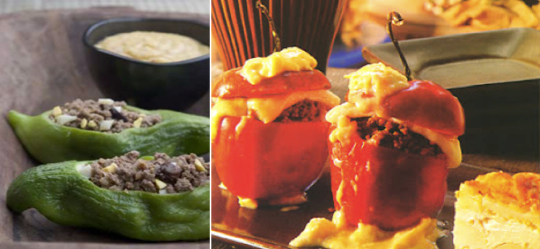
Moorish influence. Stuffed caigua (left), is a relative of chili pepper. The hot rocoto as stuffed here (right), is a popular dish that comes from Southern Peru
Another example of a Peruvian dish using native ingredients adapted to Spanish tastes and culinary methods, with origins in Moorish cuisine, is the fish escabeche (2), in which fish is fried, then marinated with hot chili peppers and onions, and is accompanied with sweet potatoes. Other dishes that predated the Spanish conquest were also adapted into the criollo tradition, such as causa (also below), made from potatoes mashed with lime juice and chili pepper.

Peruvian fish escabeche (left) includes chili peppers and sweet potatoes.
The potato dish causa (right) is stuffed with avocado or minced seafood
Ceviche, featured in our commentary last month, is a further example of the long evolutionary process leading to the fusion we call today Peruvian cuisine. Early versions of ceviche date back from the Incan period and even before then. They were prepared in coastal communities with fresh fish, chili pepper and the juice of acidic fruits such as tumbo or passion fruit. Tumbo is shown (below) in the form of a pre-Columbian ceramic from the pre-Incan Moche culture (3). It has very high levels of vitamin C.
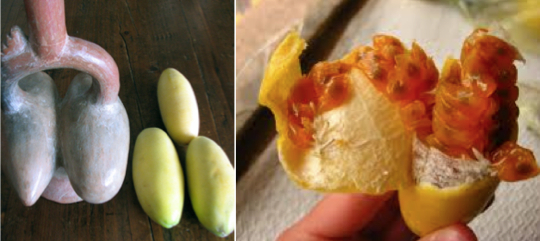
In pre-Columbian times (shown as pottery, left) tumbo fruit was used to marinade fish. Now it is eaten fresh or else prepared in desserts and sorbets
The women who arrived with the Spanish conquerors during the first decades of the colonial period, as settlers in the period of the viceroyalty, brought their own knowledge of food and meals, including recipes and foodstuffs. Many recipes were from the Moorish tradition, a fusion of North African Arabic and Spanish cuisines developed over eight centuries. The women settlers in colonial cities varied the local raw fish preparation, giving it a new savour by adding Spanish ingredients such as the juice of sour oranges instead of tumbo, and red onion slices. This recipe stayed relatively unchanged until the first decades of the last century, when lime juice replaced the sour orange juice. Since the 1980s, because of the contribution made by Peruvian cooks of Japanese descent, the fish in ceviche is marinated in lime juice for only about three minutes, or even less, far shorter than the original one-hour marinading. The popularity of Peruvian ceviche continues to grow, in Peru, in Latin America, and now all over the world.
Peruvian native foods
The main reason for the rise of Peruvian cuisine is its rich mixture of traditions both of agriculture and of gastronomy, and of food cultures from successive original people up to and including the Incas, and then people from Spain, North Africa, various European countries, China and Japan. Like in other parts of Latin America, the staggering terrain of Peru ensured that the native people and their ways of life survived, to be fully appreciated only recently.
Here follows a short selective sample of Peruvian foods, products and dishes. Some of them have been commonly enjoyed for many generations, some others have been introduced in recent times, and some others are still uncommon.
Corn (maize)
There are 45 native varieties of corn in Peru. The most praised variety is the giant white corn of Cuzco. Corn is a staple food, used in a vast variety of foods and dishes, such as breads, tamales, stews, soups, and hot and cold drinks, known as chichas. The humble cancha --roasted corn kernels – mostly ignored in big cities until the early 1980s, is now hugely popular everywhere.

Left: Varieties of corn at a local Andean market. Right: Chicha morada, a refreshing drink made of purple corn, as rich in flavonoids as red wine.
Quinoa
In the Incan culture, quinoa was referred to as chisiya mama or 'mother grain'. The Spanish discouraged its cultivation because of its use in indigenous religious ceremonies, introducing instead barley and wheat. Quinoa stayed marginalised but was never lost among Andean people, going unnoticed among the urban population until the last century (4). Next year, 2013, has been declared the International Year of Quinoa by the United Nations General Assembly. Reasons given for this decision include the nutritional value of quinoa (notably its high protein content with specific amino acids – lycine and isoleucine – of which other grains are poor sources), its biodiversity, and its place within the food systems of native people, enabling them to live in harmony with their environment and protecting food security. Within Peru, quinoa has once again become a valued food of the Andean people, and also the urban middle classes. It works as a grain for home-made breakfast cereals and as the main ingredient in versions of soups, tamales, taboulleh, risottos and desserts.

Here is quinoa as gathered (left) and (right) used in a type of taboulleh salad. Quinoa is versatile used as a grain, and also is naturally grown in the Andes
Cañihua
The resilient cañihua plant produces grains for human consumption at between 3,500 meters and over 4,000 metres of altitude. It resists very low temperatures and survives extended droughts. It supports subsistence farming, in part because of the large number of people required to harvest it and its small grain size. It is very high in protein. It is traditionally eaten lightly roasted and ground as cañihuaco, as a type of porridge, and also as a hot or cold drink. Production, which shrunk from 7,000-8,000 hectares in the 1970s to around 5,000 hectares recently, is now being boosted (5).
As well as quinoa, kiwicha and cañihua are now becoming better known nationally and also internationally. All three are good sources of protein, and also have high levels of antioxidants (phenolic compounds), zinc and iron.

Cañihua is a very high protein grain that flourishes at altitudes even higher than 4,000 metres. Its origin is in the Andes of southern Peru and Bolivia
Box 2
Nutrients in native foods
This and the previous commentary have plenty to say about nourishment in the general sense of the word – that which promotes general good health and well-being. But information here about nutrition in the more precise sense, referring to nutrients and other bioactive compounds, is sketchy (6). This is because in Peru – and many other less-resourced countries – information in the published literature about native foods is itself sketchy, unless these have become part of the food supplies of countries with the funds to support thorough food composition analyses. This important issue is being addressed worldwide by the INFOODs initiative of the UN Food and Agriculture Organization.
The issue is troublesome, because meanwhile health professionals in less resourced tropical countries who are responsible for dietary guidelines, have to rely on food composition tables published in temperate countries that contain little or no information about tropical foods except those which are imported into temperate countries. As a result, Peruvian nutritionists, dietitians, other interested professionals, and also family members, have ready access to information about the nutritional composition of wheat, rice, beef, pork, apples and oranges, but little about native Peruvian foods until these become fashionable or exported, like quinoa. There is also little information about the variations in nutritional quality between different types and strains of the same generic food, which can and do vary greatly.
Fish
Anchoveta is a member of the anchovy family. Populations in the Pacific are exceedingly prolific even despite heavy fishing. Since the 1950s, this fish has been used almost exclusively to make fish-meal for animals. However, in 2006 a group of Peruvian chefs and food writers led by Gastón Acurio started a campaign to promote the human consumption of anchoveta, showcasing it in upscale restaurants and food festivals. Fresh or canned, it now has a solid presence in Peruvian markets.
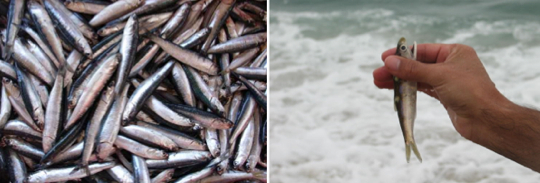
Anchoveta is a small ocean fish long disdained because of its dark flesh and small size. Boosted by Peruvian chefs and writers it is now more popular
Peppers
Peppers are a food category in themselves! Hot chili peppers (ajíes) have been used since pre-Columbian times to flavour and season food preparations. There are at least 50 varieties in Peru, but only a few of them are used in Peruvian cuisine. Peruvian hot chili peppers characteristically have a stronger fragrance and flavour than those grown in other countries.

Aia Paec, a Moche (100-600 CE) culture deity (left), represented with a body of chili peppers. (Right) Here are some varieties of Peruvian chili peppers
Cacao
Some native varieties of cacao (also known as cocoa) of excellent quality and unique flavours have been discovered in recent years. The highly prized pure nacional variety, believed to be been extinct a century ago because of a disease, was rediscovered in 2007. However, the native varieties are being threatened. The US Agency for International Development (USAID) introduced the high-yielding but inferior quality CCN-51 cacao hybrid to Peru in 2002, to offer farmers an alternative to planting coca. High quality chocolate makers are encouraging farmers to cultivate smaller amounts of rare, native cacao varieties, that fetch higher prices from buyers who value complex and subtle flavours (7).

Ashaninka men collect cacao beans from a rare Amazonian variety (at left). High quality chocolates (at right) made with native cacao, in a Lima shop
Fruits
Besides the already mentioned tumbo, there is a vast variety of delicious native Peruvian fruits. Each of them has a unique and distinctive aroma and flavour. Among the most popular are the lúcuma, rich in niacin and carotene; the granadilla, high in vitamins A, C and K, and phosphorus; the creamy cherimoya (also known as custard apple) which is a good source of vitamin C and calcium, and its juicy cousin, the guanábana, also rich in vitamin C.

Left: Lúcuma as depicted in the pottery of the pre-Incan Moche people (left) is now mostly used to make ice cream and creamy desserts such as mousses
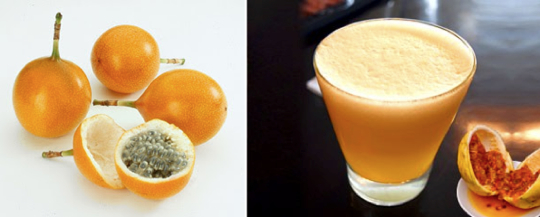
Granadilla (left) is used in making of juices and smoothies. Maracuyá is used to make desserts and ceviche and a terrific cocktail, the maracuyá sour (right)
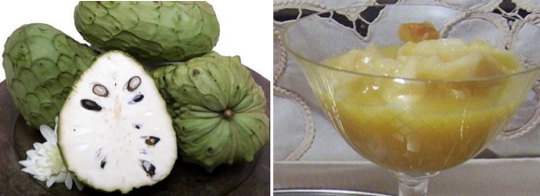
The chirimoya (custard apple) is meaty and has a silky texture. Its flesh when combined with orange juice is made into a popular, delicious dessert (right)
Herbs
Just one example of scores that could be mentioned: huacatay. This is a plant of the marigold family. Its unique flavour and aroma make it the favorite native herb for cooking. The leaves are used ground or whole, in soups, dips and sauces.

The original favourite Peruvian herb. Huacatay leaves (left). Ocopa (right), is
a huacatay sauce of pre-Columbian origin that gained an Andalusian twist
Conclusion
We hope that this and the previous commentary on Peruvian agriculture, gastronomy and nutrition does indeed become the first of a series of World Nutrition commentaries that link nutrition with the production and enjoyment of food. As well as the world outside the Americas, there is far more that needs to be known, written and understood about Peru, and also about all Latin American territories, especially those where the native peoples and customs have survived in ancestral lands. The same applies to the countries of Asia, Africa, the Arab world and Europe, where continuous traditions and ways of life have not been marginalised or extinguished. The implication is that the global North – temperate countries that have become wealthy usually as a result of exploitation of tropical countries – has much to learn from the global South. We believe that this is so.
References
- Bedoya Garland, Susana. El legado árabe del Al-Andalús en la comida peruana. Chasqui. Bulletin of the Ministry of Foreign Affairs, 8, 17, February 2011.
- Manrique, Nelson. Arabs in Colonial Peru. Chasqui, Bulletin of the Ministry of Foreign Affairs, 8, 17, February 2011.
- Museo Larco. E-Catalogue. http://www.museolarco.org/catalogo/
- FAO, Regional Office for Latin America and the Caribbean. Quinoa: An ancient crop to contribute to world food security. July 2011.
- World Watch Institute. Cañihua: quinoa's little cousin packs a nutritional punch. http://blogs.worldwatch.org/ nourishingtheplanet/ canihua-quinoas- little-cousin-packs-a-nutritional-punch/
- Repo-Carrasco Valencia, Rita. Andean indigenous food crops: nutritional value and bioactive compounds. Finland: University of Turku, 2011.
- Reuters. US anti-cocaine push embitters Peru chocolate makers. http:// www.reuters. com/article/2012/04/25/us-peru-cocoa- idUSBRE83O19I20120425
Acknowledgement and request
Concept, first and final drafts and final text approval: EJ, PM. Funding for this commentary: None. Conflicting or competing interests: EJ recently acted as Deputy Minister of Health of Peru and does not regard this as a competing interest. The commentary has been reviewed by Chessa Lutter of the Pan American Health Organization, and Elmer E. Huerta, Director, Cancer Prevention Institute at Washington Hospital, DC, USA, and past President of the American Cancer Society. Geoffrey Cannon, Editor of World Nutrition, who drafted the two boxed texts and made substantial additions and other contributions to this and also the previous commentary published in July, invited this follow-up commentary.
Readers may make use of the material in this commentary if acknowledgement is given to the Association, and WN is cited. Please cite as: Jacoby E, Murillo P. The best food on earth. Peru. The union of agriculture, gastronomy, nutrition. [Commentary].World Nutrition, August 2012, 3,8, 358-372. Obtainable at www.wphna.org.
All contributions to World Nutrition are the responsibility of their authors. They should not be taken to be the view or policy of the World Public Health Nutrition Association (the Association) or of any of its affiliated or associated bodies, unless this is explicitly stated.






